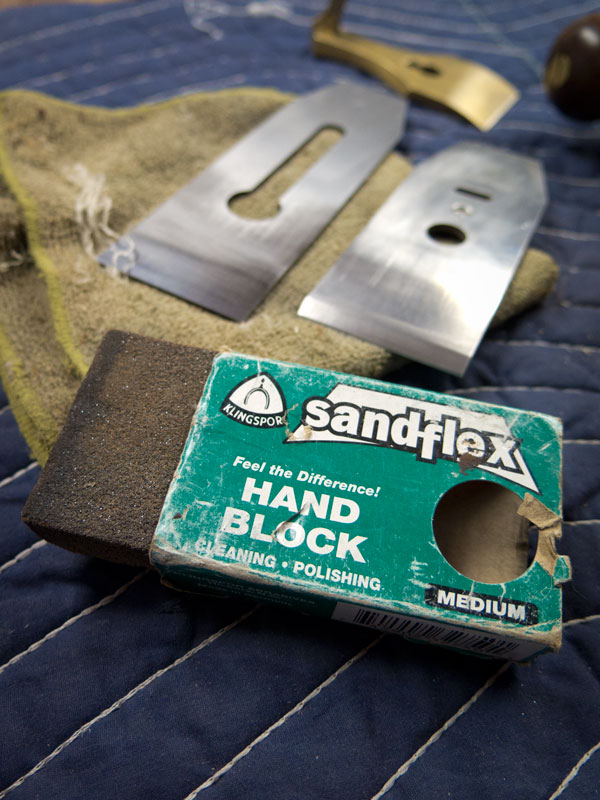We may receive a commission when you use our affiliate links. However, this does not impact our recommendations.
I wish I could send Frank Klausz to the shop of every reader to teach you the following lesson, but I think he’s busy.
The first time I met Klausz was at a woodworking show on the East Coast about 15 years ago. He was demonstrating wooden moulding planes; I was demonstrating some infill planes I had built. At one point during my demonstration, Klausz walked up to my bench and picked up my panel plane to examine it.
Then he walked away with the tool.
He returned about 15 minutes later with the tool and scolded me in front of everyone for allowing some rust to bloom on the iron and cap iron. He had taken the tool apart, cleaned it, oiled it and reassembled it.
Klausz set the bar for me that day, and I will always be grateful for the drubbing.
All tools – hand or power – need care. If you don’t have time to maintain all your tools, you probably have too many of them.
Shown above are my two primary weapons in keeping Klausz (and rust) at bay. An oily rag and a medium-grit hand block, which is basically a rubberized abrasive. The rag can be soaked with any oil. Repeat: Any oil. Even olive oil and/or motor oil. I use jojoba oil because I don’t need any more volatile organic compounds in my life.
When I finish using a tool for the day, I brush off all the sawdust and inspect the tool. If I see a spot of corrosion, I remove it with the hand block. Then I wipe the tool with the oily rag. When I sharpen a tool, I inspect the tool closer and remove any pitch on the cap iron with the hand block.
Every year (about this time of year, actually), I take an hour to strip my planes completely and put some machine oil on all the moving parts.
The result? No more scoldings and no more rust.
— Christopher Schwarz
The next best thing to taking a class with Frank Klausz is his seven-hour DVD on joinery “Joinery Master Class.” It’s fantastically priced. You can even download the entire thing and take Frank with you wherever you go (scoldings not included).
Here are some supplies and tools we find essential in our everyday work around the shop. We may receive a commission from sales referred by our links; however, we have carefully selected these products for their usefulness and quality.











It may not be the ‘right’ way to do it, but I’ve always used plain old floor wax on my tools. It’s easy to apply and doesn’t come off on your hands (and everything else) after it’s buffed out. It does have to be reapplied every so often and may not work in extremely wet environments. I don’t have huge temperature/humidity swings in my shop, so your mileage may vary.
We have a dehumidifier in the garage. It works fine except when there is a sudden change in temperature and the conditions are just right for moisture on everything but the temperature is just below the limits of the dehumidifier. For liquid protection (Boeing) Bo-Sheid T-9 has been a good choice for several years and more recently find CRC Marine 6-56 to be very good. Another CRC product used in a magazine test seems difficult to find. Other measures include glad wrap and glad Press and seal. I keep a box under the work bench and transfer it to the kitchen when that box is empty. A nuisance is protecting chisels etc against the cloth welting in the typical tool roll – leaves a nice stripe of rust; resolved by placing desiccant paper or glad wrap plus soaking the welting with T-9 etc. Another bit of protection is placing tools (and tool rolls) in old coffee bags. The latter look better inside out, however. Mark them before you forget. Tools of most concern are the ones hanging out, saws, hand drills and braces etc. The others are in cabinets or tool boxes. Since my tools don’t leave the premises I de-rust them (or a new tool) with a fine wire wheel in the drill press and add polishing rouge and/or polishing compound to the wire wheel or item being cleaned. Use a hand vise and keep it tight. I have several but like the aluminum one dad used – good choice, dad, you were right, again. Dad was a farm kid – good at everything.
I find rust erasers super helpful for this. The ones I think work best are offered by companies that supply sushi knives to chefs. You usually soak them in water for a few minutes before using them. They leave a very smooth surface.
The crystal kitty litter is a great desiccant. A pill bottle with holes in the top works great. It only has to be changed about every two years. I use it in every drawer of my machinist’s chest. There is always moisture around CNCs. Works just as well in my wood chests. Just find a cat lady, and ask her for a cup.
These rust remover blocks are sold as Garryflex in the UK. I use Chris’s protocol and what he did not mention keep my tools in a wood chest with no finish inside – I think they help smooth out large temperature changes and that reduces condensation on cold metal. The bare wood may also soak up moisture. I also use small sacks of silica gel, not the tiny ones sometimes found packed in with new tools but one about 6″ x 4″ x2″. Use those with a fabric bag as these can be regenerated in a microwave. BTW most glues appear to be quite corrosive and I am carefull to wipe it off my tools. I have not found volatile corrosion inhibitors (VCI) helpfull or perhaps I am too mean to spend money replacing them each year.
Might I suggest a dehumidifier should be the first line of defense against rust. I find if the relative humidity is bellow 50% in the shop, I do not have to worry about rust.
I’ve had the good luck to be able and attend a small Frank Klausz seminar (two days of sitting and listening, which isn’t hands on, but is better than nothing) and an even smaller class taught by him (15 people building boxes), both through my local woodworking guild.
I learned several important lessons from these two experiences and those lessons are as fresh now as they were the day I learned them.
Frank has a way with people. He says what he thinks. He doesn’t beat around the bush or waste time with pleasantries when he’s trying to teach. He is there to teach and you are there to learn. When you’re in Frank’s presence, you have to be open to learning. THEN you won’t be bothered by how he admonished you; you’ll just know that you were doing something the wrong way and you were corrected and you sure as hell won’t make that mistake again.
Sometimes you don’t have to be on the receiving end to get the lesson. Sometimes you are sharing a workbench with the guy who is on the receiving end. The best way to learn is through someone else’s mistakes. 🙂
But he’s also a LOT of fun. He has so much woodworking knowledge and skill and you’ll find yourself drawn to him, regardless of how he is perceived, because you can also easily see that he cares about the craft of woodworking and he genuinely wants to see everyone succeed at it. If you ever get a chance to take a class or seminar taught by Frank Klausz, I’d highly recommend you do it. But you need to approach it with an open mind, prepared to learn.
Any news on the Frank Klaus / Neil Young & Crazy Horse tour to promote their collaboration album “Frank Klaus Never Sleeps”?